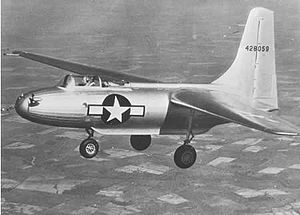- Cornelius XFG-1
-
XFG-1 Role Fuel tanker glider National origin U.S.A Manufacturer Cornelius Aircraft Co. Designer George Cornelius First flight 1944 Primary user United States Army Air Force Number built 2 The Cornelius XFG-1 was a military fuel transporting towed glider, without a tailplane and with a forward-swept wing. Two were built but development ended in 1945.
Contents
Design and development
The Cornelius XFG-1, developed under the project code MX-416[1] was an aerodynamically unusual aircraft intended for an unusual military role. George Cornelius had been experimenting with aircraft featuring differentially variable incidence since the 1920s[2]. His first two machines were otherwise conventional but the third, the Cornelius Mallard from 1943 was not, being without a horizontal tailplane and having low aspect ratio and strongly forward swept wings. Though very different in detail, the XFG-1 built on the Mallard experience. A 1/4 scale model of the XFG-1 was built for wind tunnel tests.[3]
The FG in its designation stood for fuel glider and its role was as a fuel transport. It was to be towed behind another aircraft rather like contemporary troop carrying gliders, but its two fuselage tanks held 564 Imp gal (677 US gal, 2,563 l) of aviation gasoline.[4][5] Unlike other troop carrying gliders like the Waco CG-4, the XFG-1 could be towed by modern bombers or transports at a cruise speed of 250 mph. Proposals seem to have included a piloted tow version behind a large transport, the glider landing loaded on skids having jettisoned its wheels after take off; or a pilotless version towed behind a B-29 bomber, disconnected and abandoned after fuel transfer was completed;[2][3] the intent of the scheme being for the glider to act, essentially, as a giant, winged drop tank for extending the range of the towing aircraft.[6]
The XFG-1 was a high-wing monoplane, its wing set far back towards its vertical stabilizer. The wing was quite high aspect ratio and of modest forward sweep. Though the earlier Cornelius aircraft had wings that had their incidence variable in the air, the incidence on the XFG-1 could only be adjusted on the ground, with two settings of 3˚ and 7˚.[2][5] There was no horizontal tail. It had a simple fixed tricycle undercarriage and a conventional single seat cockpit; two examples of the type were built.[7]
Operational history
Two prototypes were built and 32 flights were made between them in 1944–45[2], although the first was lost to a spin, killing the pilot. On many of the flights, but not the fatal one, the pilot was Alfred Reitherman.[8] The fuel glider concept was abandoned at the end of World War II.
Specifications (XFG-1)
Data from Fahey 1946, p. 37
General characteristics
- Crew: 1
- Length: 29 ft 3 in (8.92 m)
- Wingspan: 54 ft 0 in (16.46 m)
Performance
References
- Notes
- ^ Culy, George and Andreas Parsch. "MX-1 to MX-499 Listing." Designations of U.S. Air Force Projects, 2005. Retrieved: 12 January 2011.
- ^ a b c d Meaden January 1990, p. 47.
- ^ a b "Gliding Gas Tank May May Refuel Planes On Ocean Hops." Popular Science, August 1944, p. 124.
- ^ Fahey 1946, p. 37.
- ^ a b "The Rise and Demise of a Weapon, Part Four." Air Enthusiast, June 1972, p. 320.
- ^ Bowers 1990, p.264.
- ^ Miller 2001, p.207.
- ^ Meaden February 1990, p. 44.
- Bibliography
- Bowers, Peter. M. Unconventional Aircraft. Blue Ridge Summit, PA: TAB Books, 1990. ISBN 978-0830684502.
- Fahey, James C. US Army Aircraft 1908-1946. New York: Ships and Aircraft, 1946.
- Meaden, Jack. "Letters section: Cornelius' experiments." Flight, 24-30 January 1990, p. 47.
- Meaden, Jack. "Letters section: "Mallard pilot". Flight, 14-20 February 1990, p. 44.
- Miller, Jay. The X-planes:X-1 to X-45. 3rd edition. Hersham, Surrey, UK: Midland Publishing, 2001. ISBN 978-1857801095.
USAAC/USAAF glider aircraft designations Assault Glider AG-1 • AG-2
Bomb Glider Cargo Glider Fuel Glider FG-1
Powered Glider Training Glider Lists relating to aviation General Aircraft (manufacturers) · Aircraft engines (manufacturers) · Airlines (defunct) · Airports · Civil authorities · Museums · Registration prefixes · Rotorcraft (manufacturers) · TimelineMilitary Accidents/incidents Records Categories:- United States military transport aircraft 1940–1949
- United States military gliders 1940–1949
- Cornelius aircraft
- Forward-swept wing aircraft
- Tailless aircraft
Wikimedia Foundation. 2010.

